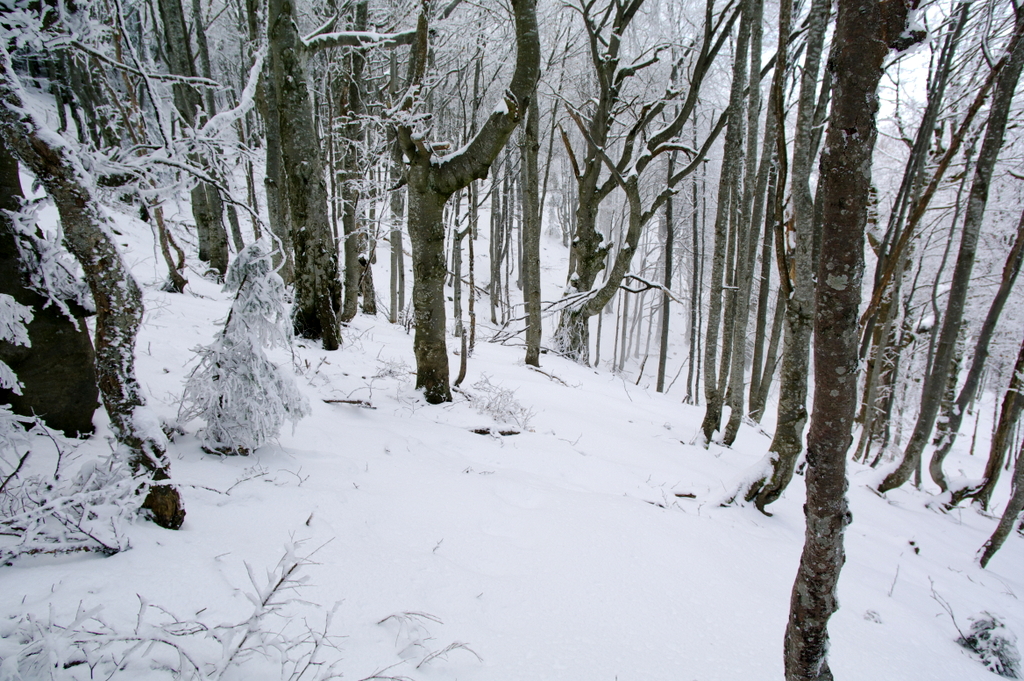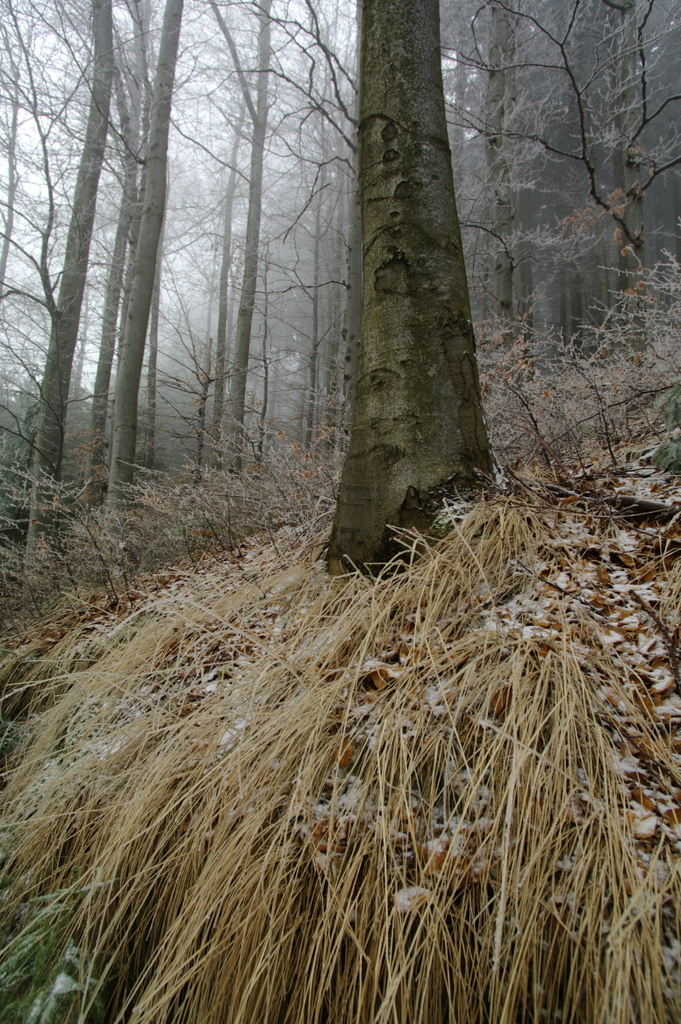A journey from the west to the south-east and to the
south-west.
Tha chain or the Carpathian mountains has a lenght of
about 1.500 km and stretches across the territory of seven countries This is a place of great nature diversity,
where east meets with west and south gets together with north. Though a single
phenomenon connects like a belt all regions along this vast distance: the
carpathian beech forest.
Stužica Natural Preserve in north-east Slovakia, on Polish-Ucrainian borders. Poloniny National Park. August 2000.
I wished for a very long time to write down an article
about the beech forest in the Carpathian Mountains, wich fascinates me so much.
To be in a position do so I had to spent over a year in the Carpathian
Mountains on foot, with a sleeping bag and a camera. I invite you to follow me
on such a journey. It is rather an inner journey, which is not obvious for
everyone. Most people even don’t notice differencies in nature, or they simply
don’t know to realize what the changes are, and are not able to point them out.
This article comes to help to make all clear.
Not being a trained botanist I can not determine the
lichen species. I encourage readers with better knowledge than mine to leave a
comment below the article. It would be cooperative not only for me. It would be
useful for the readers alike.
Beech bark with algae, Habrůvecká bučina Natural Preserve, Moravian karst, the Czech Rep. May 2012.
Beech bark, Habrůvecká bučina Natural Preserve, Moravian karst, the Czech Rep. May 2012.
Beech bark with algae, Habrůvecká bučina Natural Preserve, Moravian karst, the Czech Rep. May 2012.
Beech bark, Habrůvecká bučina Natural Preserve, Moravian karst, the Czech Rep. May 2012.
Having been traveled all the way along the arc of the
Carpathian Mountains, since 1990, I gained an remarkable vision on their
natural habitats.
Beech bark with lichens, Muntii Semenic, Romania. May 2011.
If anyone can determine the lichen species shown here, I encourage such a person to leave a comment below the article.
Beech bark with lichens, Muntii Semenic, Romania. May 2011.
If anyone can determine the lichen species shown here, I encourage such a person to leave a comment below the article.
In the Carpathian mountains about 50 % of the total
area is covered by forests. The main forest tree is Fagus sylvatica, which compose
several types od beech forest in the mountains. Beech woods are varied, due to
the altitude, exposure, soil quality and particular geographical position along the arc of the
Carpathian Mountains.
Beech forest in the Carpathians differs from beech woodland
in other parts of Europe by several plant, animal and insect species. This
article rather focuses on visual selection in between different parts of the
Carpathian Mountain Range, than on specificic diversities from a scientific
point of view. Most visitor of the forest are laymen, who lack knowledge of
telling out differencies in between plant communities and species.
Beech forest in Moravian karst, the Czech Rep. Though being outside of the Carpathian Range, we still name them the carpathian beech forest. Its not only because of its proximity to that mountain range, it's because of several plant species, which determine the carpathian forest type. In this case it is Carici-pilosae-fagetum, with Hairy sedge on the forest floor. May 2012.
There are several important plant and animal groups
which can help us to tell whether we are in the Carpathian Mountains chain or
not, or even they can inform us in which part of the arc we are. Several plant
and insect types occur also in the Hercynian forest, west of the Carpathian
Mountains. Although we mention these species as significant to the carpathian
forest itself.
In lower elevations of the beech forest occurs Hairy
Sedge (Carex pilosa), which is dominant in the beech forest floor in the
Carpathian Mountains (Carici-pilosae fagetum). Going higher in foothils these
forest are replaced by Melico-fagetum. Higher up in the mountain zone the typical
species for the carpathian beech woodland is Dentaria glangulosa, which does
not occur farther west. Beech forest with Symphytum cordatum is another native
habitat found in the East Carpathians, starting to make occurence in the East
Slovakia, while being absent in the West Carpathians.
Carpathian endemite is mollusc Coelsia coerulans,
which does not occur outside the carpathian massif, with one exception (outside
of the Carpathian Mountains is found only in the Hrubý Jeseník Mountains, the Czech
Rep.).
Representative for mountain forest is Giant Springtail
(Tetrodontophora bielanensis), though it mainly occurs in mountain spruce
forest, and its range is not limited to the Carpathian Mountains. Frequent in
mixed beech-fir forest in the Carpathians is Eisenia lucens, an earthworm,
which occurs also outside the Carpathian Mountains.
I always was fascinated by the appearance of beech
forest in the Eastern Carpathian Mountains. They look so differently, when
compared with beech forest of my home country.
The carpathian beech forest in Leaota Mountains, Romania. May 2012.
Beech forest in the Leaota Range, Romania. May 2012.
Sometimes I had a feeling that I am in birch forest
instead of beech forest. The distinction was in color of the tree bark!
Sometimes the trunks appears to be almost white and not grey. In our parts the
color is also varied, though never reaches the paleness the trees farther to
the east have.
The carpathian beech forest in Godeanu Mountains, Romania. November 2011.
The carpathian beech forest in Godeanu Mountains, Romania. November 2011.
When I compare my photographs I have made during my
travels in last decade I can say the the lichens are what visually distinguish
different regions in the Carpathians.
Lichen covered beech trunk, Leaota Mountains, Romania. May 2012.
Beech forest in winter cloak. Vrancea Mountains, Romania. December 2011.
Winter in beech forest. Vrancea Mountains, Romania. December 2011.
Winter in beech forest. The Nemira Range, Romania. December 2010.
Lichens are considered to be indicators of the value
of the enviromnment. The cleaner the air is the more species of lichen occur,
and vice versa. Moisture is another distinctive feature, which affects biota.
When combined together, they have wide influence on occurence of epyphitic
lichens in beech woodland.
Beech trunk in detail. The Leaota Mountains, Romania. May 2012.
Beech trunk in detail. The Leaota Mountains, Romania. May 2012.
I am sure that a hundred years ago, the beech forest
in our parts had about the same paleness as they have it now farther toward the
east. The proof is in old photographs made in the middle of the 20th
century by nature photographers (R. Janda).
Mionší natural preserve, one of the remnant of typical mixed fir-beech forests in the Carpathians in the Czech rep. Visitors have a feeling that they entered a real carpathian forest there. It also has several meadows, caled "polana" as a local idiom. The word "polana" was brough by walachian colonists (the Walachian colonisation) onto our territory in the past. The forest was made famous by a Czech photographer R. janda in 1940'. other parts of the mountain range are covered with mostly artificialy introduced spruce monoculture forests. A process which began in the middle of the 18th century, and stil continues up to this date. July 2011.
Being lucky enough to visit all important mountain
ranges in the Carpathian Mountains, I can say how they differ in a short photo
story. I don’t say that a forest in the Banat Mountains is perfect, while a
forest in the Beskydy Mountains is not. Forest contrast in relation of its
location, and even in our parts I can find a piece of beech forest, which look
like exactly the same as the forest in Almaj Mountains in romanian West
Carpathians, for example.
Beech forest in Almaj Mountains, Banat. Varfu Kopřiva. This forest scene can be mistaken for that out of Slovakia or even the Czech Rep.,because of a tourist marking shown on a tree, developed in former Czechoslovakia. Lichens are absent, there is almost no hint to say that the photo was made in Romania.
Beech forest in The Semenic Mountains, Romania. May 2011.
Beech forest in the Semenic Mountains, Romania. May 2011.
Beech forest in the Semenic Mountains, Romania. May 2011.
Beech forest in Podu Calului, below Golul Teharaului, the Buzau Mountains, Romania. September 2012
Where is the boundary between poluted and clear air, which is vital for surviving so called bio-indicators? There is no sharp boundary, though species drop away one by one when going from the east to the west. The transition zone is on the border with Slovakia. Eastward lichens become more frequent. Malá Fatra Range is the first barrier of really high mountains when going from the west to the east. The number of species of lichens increases there, though doesn’t reach the wealth of the Eastern Carpathians.
Beech forest in the Beskydy Mountains, the Czech Rep. No lichens shown here, only algae. February 2011.
Similar view as the previous one. Bark has dark grey color. The Beskydy Mountains, the Czech Republic, February 2012.
In another part of the Beskydy Mountains, deeper into the massif, the bark is covered with some lichens. Klíny Natural Preserve, the Czech Republic. October 2010.
Beech forest in Strážovské Vrchy Mountains, Central Slovakia. July 2010.
Beech forest in Malá Fatra Range, Central Slovakia. May 2012.
Beech forest in Velká Fatra Range, Central Slovakia. October 2011.
Beeches in Velká Fatra Range, Central Slovakia. December 2009.
Beeches in Velká Fatra, Central Slovakia. December 2009.
Beech forest in Velká Fatra Range, Central Slovakia. December 2009.
The second zone of change are the High Tatra and Low
Tatra Mountains. Beyond them are Eastern Carpathian Mountains with fauna and
flora less touched by humans. From there there are not many changes in lichen
flora all the way to Banat Mountains on the south-west end of the Carpathians.
For example, a lichen species typical for mountain spruce forest (Usnea
family), also an indicator of air quality. It starts to reach bigger dimensions
at the Low Tatra Mountains and on the Muráňska Planina Plateau. In the Fatra
Mountains its reaches only about a half of the size of its relatives beyond the
Tatra Mountains.
Beech forest in Slanské Vrchy Range, Velký Milíč massif, East Slovakia. July 2011.
Beech forest has almost "romanian" look. Velký Milíč massif, East Slovakia. July 2011.
Though the true whiteness in beech forest begins in
the Ucrainan sector of the East Carpathian. Only there and in Romania you can
mistaken it for birch forest at the first glance.
Beech forest in ucrainian Carpathians. The Svidovetz massif, Stredná Rika Valley. July 2010.
Beech forest in the Semenic Mountains, Romania. May 2011.
Beech tree in Mehedinti Mountains, Romania. May 2012.
Beech forest in the Mehedinti Mountains, Romania. May 2012.
Beech forest in Cernei Mountains, Romania. May 2012. For reference see the image right below.
Similar forest type as above. This time in Strážovské Vrchy Range in Central Slovakia. July 2010.
Beech forest below Vápeč Peak, Strážovské Vrchy Range, Central Slovakia. July 2010.
Beech tree in Velká Fatra Mountains, Central Slovakia. October 2011.
Beech forest in Semenic-Cheile Carasului National Park, Romania. May 2011.
Beech forest below Cheile Tasnei, Mehedinti Mountains, Romania. May 2012.
Beech forest above Cheile Tasnei, Mehedinti Mountains, Romania. May 2012.
The carpathian beech forest seen through eyes of an artist. Picture made by a contemporary artist Adrian Stoenica, Romania. Image taken in December 2010.


















































Žádné komentáře:
Okomentovat